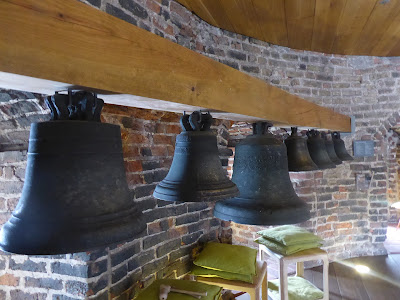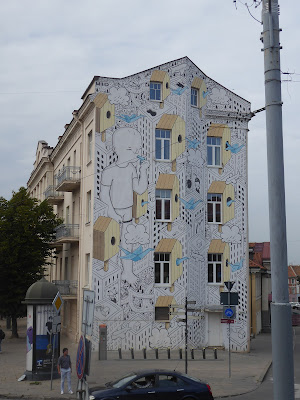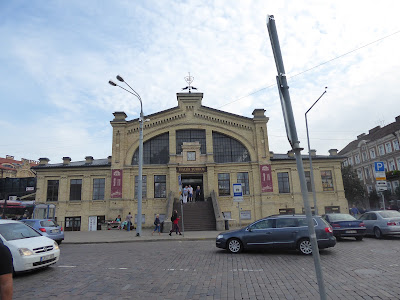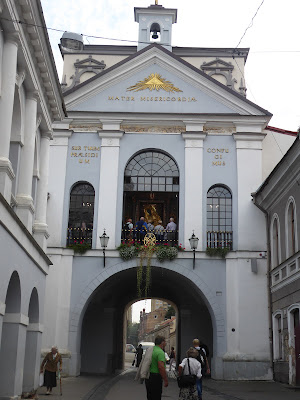I had arranged to meet my friend M at midnight at Vilnius airport. My flight was a two and a half hour evening flight from London but M had five connecting flights from Edmonton, Canada. The likelihood of us meeting seemed slim so we had a back up plan of just meeting up at the hotel the next day. Miraculously M was there waiting for me at the airport and we got a taxi to the hotel, for which we paid a ridiculous amount. It was about 1am when we arrived at the hotel reception. Just about to head off to our room when M realised she had left her phone in the taxi. A very amused receptionist called a 'city' taxi to take us back to the airport for a fraction of the cost of an airport taxi! It didn't take us long to find the taxi driver. He searched his cab but couldn't find it. However, M found the phone, in her bag!! The driver offered to take us back to the hotel. With steam coming out of my ears I told him in no uncertain terms that we would not be going in his overpriced taxi. At one point I thought we would never get back to the hotel but then we found a driver who would take us back for a more reasonable price but still four times the cost of a city taxi.
We were in Vilnius to join a Gadventure tour of the Baltic States but that wasn't starting for a couple of days so we had lots of time to explore on our own. The next morning we walked into the old town of Vilnius and I had my first view of an onion domed church. This is the Russian Orthodox church of St Michael and St Constantine also known as the Romonov church. It was built in 1913 to commemorate 300 years of the Romanov dynasty.
I enjoyed the details on the buildings
This is the Russian Drama Theatre of Lithuania. Its past history includes it being the first Lithuanian Gymnasium in Oct 1915 and also where the Lithuanian conference took place in Sept 1917 to elect the council of Lithuania which was commissioned to create an independent state.
After about 20 minutes we arrived in the Old Town.

We had a look inside one of the many churches. It was surprisingly light inside as well as ornate.

In Cathedral Square is the bell tower which is separate from the Cathedral. I walked to the top. It was a steep climb up 140 wooden steps which were irregular in height making it a bit of a work out.
It was an unusual view looking down on the bells. I assumed that the bells were old but in fact at the end of WW1 the retreating Russian army took away the church bells en masse and during WW2 there were no cathedral bells. In the Soviet period (1944-1990) a number of bells were brought to the Cathedral from various churches in Lithuania. After independence a number of the bells were returned to their respective churches whilst some remain on exhibition here.

It wasn't until 2002 that six new bells were consecrated in the Cathedral square, a gift from the City of Cologne, Germany.

From the tower you had a good view of the Cathedral and the Old Town.
Gediminas tower on the hill behind the cathedral.
Looking down on Cathedral Square.
The sundial on the side of the Palace of the Grand Dukes, used for telling the time in days gone by.
Inside the courtyard of the reconstructed Palace which is now a museum and art gallery.
Twice a week there is a free walking tour called the 'Alternative' tour of Vilnius. There is a daily morning tour of the old town but we had missed that one so we decided to join Violete's tour which, fortunately, was in English. This tour took us to places tourists wouldn't normally visit if you were just here for a couple of days. We decided to take advantage of being there on a Saturday when this tour took place and leave the rest of the main sights for the next day.
We were taken to the area of Snipiskes, which the locals refer to as 'Shanghai' because of its fast transformation from small village to large business area. However, one part remains of the 19th century village of wooden houses. A number of the houses had corrugated roofs.
Most of them are heated with wood burning stoves and have no running water. They have to get their fresh water from a pump. There is also no sewage system. This village is an indirect heritage of Soviet urban planning where new districts would be built whilst others were left untouched.
The new city centre is a stone's throw away with the Europa Tower the highest building in the Baltics, towering above the wooden houses.
In the 1980s, the Soviets had decided that this would be the new city centre. It was here they built the largest department store in Vilnius as well as a planetarium.
They also built a 22 story hotel which is now a Radisson Blu hotel.
The guide then took us on a local bus to the bus station and a tour of that area which had some interesting murals.
This is a work by the street artist Mindaugas Bonanu and depicts a kiss between Vladimir Putin and Donald Trump. After it was vandalised the artist decided to slightly change it. Instead of a kiss, it now depicts a smoke they are sharing.

There was quite a lot of street art around this area.

This one on the side of the building is interesting especially the painting around the windows making them look deep set into the building.

Close by was Hales market which has been here for over a hundred years. It is a place to find locally produced organic food as well as bakeries, butchers, cheese, wine and bagel shops.
The three hour tour ended here so where better to stop for something to eat and drink. We bought a couple of pasties from the bakery . One was chicken and the other was mushroom. They were some of the tastiest food we experienced during our stay in Lithuania.
We decided we would walk back to our hotel from here admiring the sights and sounds of the city which were all new to us. We began the walk through the Gates of Dawn. This arch was one of the defensive gates built in Vilnius between 1503-1522. This was the tallest of the gates. The Russians destroyed the defensive wall in 1799 together with all the gates except for this one. It is thought they were scared to demolish the home of a very religious painting.

The gate is one of the most important religious and historical monuments in Vilnius as the painting of the Blessed Virgin Mary Mother of Mercy is located in the chapel above the gate. As we watched from below we could hear a choir singing and prayers being said by pilgrims who travel to this holy site.
It was a long walk back to the hotel but an interesting one.
We were in Vilnius to join a Gadventure tour of the Baltic States but that wasn't starting for a couple of days so we had lots of time to explore on our own. The next morning we walked into the old town of Vilnius and I had my first view of an onion domed church. This is the Russian Orthodox church of St Michael and St Constantine also known as the Romonov church. It was built in 1913 to commemorate 300 years of the Romanov dynasty.
I enjoyed the details on the buildings
This is the Russian Drama Theatre of Lithuania. Its past history includes it being the first Lithuanian Gymnasium in Oct 1915 and also where the Lithuanian conference took place in Sept 1917 to elect the council of Lithuania which was commissioned to create an independent state.
We had a look inside one of the many churches. It was surprisingly light inside as well as ornate.
In Cathedral Square is the bell tower which is separate from the Cathedral. I walked to the top. It was a steep climb up 140 wooden steps which were irregular in height making it a bit of a work out.
It wasn't until 2002 that six new bells were consecrated in the Cathedral square, a gift from the City of Cologne, Germany.
From the tower you had a good view of the Cathedral and the Old Town.
Gediminas tower on the hill behind the cathedral.
Looking down on Cathedral Square.
The sundial on the side of the Palace of the Grand Dukes, used for telling the time in days gone by.
Inside the courtyard of the reconstructed Palace which is now a museum and art gallery.
Twice a week there is a free walking tour called the 'Alternative' tour of Vilnius. There is a daily morning tour of the old town but we had missed that one so we decided to join Violete's tour which, fortunately, was in English. This tour took us to places tourists wouldn't normally visit if you were just here for a couple of days. We decided to take advantage of being there on a Saturday when this tour took place and leave the rest of the main sights for the next day.
We were taken to the area of Snipiskes, which the locals refer to as 'Shanghai' because of its fast transformation from small village to large business area. However, one part remains of the 19th century village of wooden houses. A number of the houses had corrugated roofs.
Most of them are heated with wood burning stoves and have no running water. They have to get their fresh water from a pump. There is also no sewage system. This village is an indirect heritage of Soviet urban planning where new districts would be built whilst others were left untouched.
In the 1980s, the Soviets had decided that this would be the new city centre. It was here they built the largest department store in Vilnius as well as a planetarium.
They also built a 22 story hotel which is now a Radisson Blu hotel.
The guide then took us on a local bus to the bus station and a tour of that area which had some interesting murals.
This is a work by the street artist Mindaugas Bonanu and depicts a kiss between Vladimir Putin and Donald Trump. After it was vandalised the artist decided to slightly change it. Instead of a kiss, it now depicts a smoke they are sharing.
There was quite a lot of street art around this area.
This one on the side of the building is interesting especially the painting around the windows making them look deep set into the building.
Close by was Hales market which has been here for over a hundred years. It is a place to find locally produced organic food as well as bakeries, butchers, cheese, wine and bagel shops.
We decided we would walk back to our hotel from here admiring the sights and sounds of the city which were all new to us. We began the walk through the Gates of Dawn. This arch was one of the defensive gates built in Vilnius between 1503-1522. This was the tallest of the gates. The Russians destroyed the defensive wall in 1799 together with all the gates except for this one. It is thought they were scared to demolish the home of a very religious painting.
The gate is one of the most important religious and historical monuments in Vilnius as the painting of the Blessed Virgin Mary Mother of Mercy is located in the chapel above the gate. As we watched from below we could hear a choir singing and prayers being said by pilgrims who travel to this holy site.
It was a long walk back to the hotel but an interesting one.
